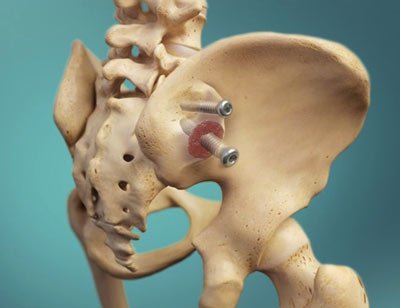Pelvic pain can affect your lower back, your legs and your groin. It can limit how you walk, how you stand and how you sit. In short, it can lower your quality of life. The pain experts at New York City pain management may try non-invasive treatments first to get you back on your feet, but if they fail to provide results, a sacroiliac (SI) joint fusion surgery may be the answer. This minimally invasive surgery fuses your SI joint, reducing pain and adding stability. Call now to get out of pain!
The sacroiliac (SI) joints are the small bones located at the end of your spine between the hip bones and sacrum at the bottom of your spine. The SI Joints connect your hip bones to either side of the sacrum. It’s the part of your pelvis that’s responsible for protecting your spine and giving your hips some mobility as you sit and pivot. These joints also act as shock absorbers.
When one of these joints, comprised of a synovial joint and connecting ligaments, becomes compromised due to deterioration or injury, it can cause pain throughout your pelvic region, hips, lower back, and groin. While most cases of sacroiliac joint pain can be treated with more conservative methods such as rest, medication, injections or physical therapy, sometimes your best hope for pain relief is through a surgery called sacroiliac joint fusion.
Who Is Susceptible to SI Joint Dysfunction?

- Extreme stiffness and reduced mobility in your hips, low back or legs
- Debilitating pain occurring in your low back, legs, hips or groin that encroaches or hinders everyday activities
- Pain that increases after sitting, standing or lying in certain positions for a long period of time
- Pain and instability that hinders walking, standing or moving and that worsens going up stairs or uphill
Diagnosis of SI Joint Dysfunction
Your doctor at New York pain clinic performs an extensive physical exam while asking lots of questions regarding your medical history, including any accidents and injuries. He wants to know about your symptoms and when they seem to be most uncomfortable. He may press on your sacrum, low back and hips to see exactly where your pain is located. Often, your pain management specialist uses a combination of symptoms and results to reach an SI joint dysfunction conclusion.
To rule out other possible causes of your pain, your doctor may order imaging tests such as x-rays or an MRI. One of the most definitive tests that serves as an initial treatment is an injection test. He injects medication that includes anti-inflammatory steroids and pain relievers all around your SI joint. If it relieves your pain, that confirms your sacroiliac joint problems.
The SI Joint Fusion Procedure
Due to the injury or deterioration of your SI joint, you may not only experience pain, but also a sense of instability, as if your hip doesn’t provide the necessary grounding you need for sitting, standing or walking. The goal of SI fusion is to use a bone graft or some other instrument to encourage bone growth over the SI joint, creating an immobile unit. This reduces the pain associated with a so-called free-floating SI joint and provides the needed stability to move correctly.
For this procedure, you’re put under general anesthesia. Using minimally invasive techniques, your NY injury doctor makes a small incision, no larger than two or three centimeters, in the side of your buttock while you lie face down on the operating table. Because of the general anesthesia, you won’t feel any pain.
Using a small guide pin to access the ilium through small drilled holes, your doctor may choose to remove any cartilage or soft tissue that could impede a bone graft. Often, using your own bone from the drilling or some other appropriate place, your doctor then implants the bone and holds it in place with pins or screws. The entire procedure takes between an hour and 90 minutes.
Recovery from SI Joint Fusion Surgery
After closing the incision, you’re observed as you wake up. You’ll most likely continue to feel discomfort and instability for a few weeks after surgery; the bone graft takes time to grow around the SI joint. Your top pain relief doctors in NYC may recommend pain medication, a special pelvic brace or a cane or walker to give you extra stability and pain relief.
After your pain has declined, you need to follow a physical therapy regimen to increase your flexibility and strength while you continue to heal. SI joint fusion surgery isn’t your doctor’s first option when treating your SI joint dysfunction, but it may be essential to give you the stability and pain reduction that you require. Contact Pain Management NYC to find out how to ease your pelvic pain.

Leon Reyfman, MD, is a top-rated, best-in-class interventional pain management doctor. He is a nationally recognized pain relief specialist and is among the top pain care doctors in New York City and the country. He is an award-winning expert and contributor to prominent media outlets.
Dr. Leon Reyfman has been recognized for his thoughtful, thorough, modern approach to treating chronic pain. He has been named a “top pain management doctor in New York” and one of “America’s Top Doctors™” for advanced sports injury treatments. Among other accolades, he was voted by peers as a “Castle Connolly Top Doctors™” and “New York Super Doctors™”. Dr. Leon Reyfman was a part of the medical team at the 2016 Summer Olympic Games in Rio de Janeiro, Brazil.
